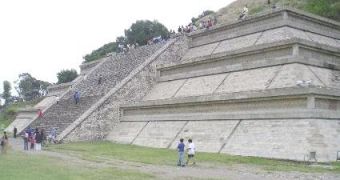Did you know the roots of words like "tomato", "chocolate", "ocelot" or "avocado"? They all come from Nahuatl, the language of the Aztecs. The Aztecs were a warlike and deeply religious people, who ruled an Empire stretching over most of today's central Mexico. They are more known for their bloody rituals of ripping the hearts while still alive from the chests of sacrificing victims in the honor of their gods; but this complex civilization also built monumental works, from temples to huge pyramids.
Their domination began in the 14th century and ended while in its peak in the fights with the Spanish conquistadors, led by Hernan Cortes., in 1521. Few people know that the Aztecs were quite new in the areas, coming from the southwestern US, and being related to some Indian tribes like Paiute, Shoshoni, Comanche or Hopi.
Archaeologists have now found what seem to be the ruins of an Aztec pyramid destroyed by vengeful Spanish conquerors in what is now one the worst neighborhoods of Mexico City.
Construction workers dug ancient walls in the busy Iztapalapa neighborhood in June, and government archaeologists think they may be part of the main pyramid of the Aztec city, erased by conquistador Cortes in 1521.
Iztapalapa, better known for violent crime and drug dealing, is one of the poorest districts of the Mexican capital. "We knew the general location but couldn't explore because it's a big urban area," said government archeologist and director of the site Jesus Sanchez.
The army of Iztapalapa's ruler, Cuitlahuac, almost destroyed Cortes' army of Spanish conquistadors in 1520 during the Sad Night; but in 1521, Cortes managed to destroy the Aztec capital.
The city's main pyramid seems to be located under the neighborhood's central plaza and garden. Sanchez's team will investigate for at least one more year before deciding if an excavation is necessary. Mexico's capital is filled with pre-Hispanic ruins. In October 2006, archaeologists found in the central Zocalo Square a 15th-century Aztec altar and a 12-tone stone idol just a few meters from the busy downtown traffic, this being the greatest Aztec finding in 30 years.

 14 DAY TRIAL //
14 DAY TRIAL //